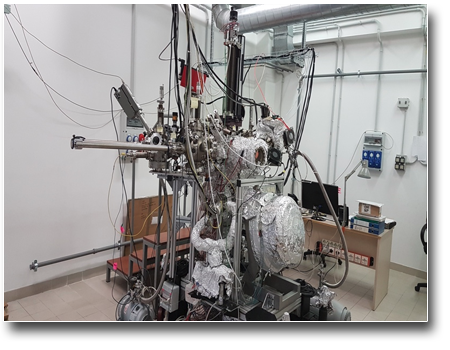
Giorgio Contini -
Nicola Zema -
Luisa Ferrari -
Stefano Iacobucci -
Massimo Brolatti - Associato ISM -
Research Activities
The research interest of SAMOS Lab focus on two-dimensional nanostructured materials mainly based on molecular self-assembly on surfaces, and on how to control their size, shape and composition. Aim of the laboratory is to develop organic molecular structures on surfaces that are of particular importance for molecular electronic devices, sensors and catalysis.
Surface-confined polymerization
The polymerization of functional molecules on surfaces is a very promising bottom-up strategy to build one- and two-dimensional (1D, 2D) conjugated polymers, new alternative materials to graphene, presenting some advantages in comparison to inorganic materials in economic terms and for their possible use in flexible electronics. The aim is the production of polymers with tunable electrical conductibility to be used as active media for electronic devices and photonics. Through the appropriate choice of the monomer is possible to obtain a polymer with different geometries and the resulting change in the characteristics of the electric charge transport in the device. Main activities are focused on the application of the Ullmann and Schiff methods for the realization of polymeric structures, respectively in ultra-high vacuum and under liquid. Ullmann method involves the use of molecules containing halogen atoms that detach through the interaction with the catalytic surface leaving dangling bonds for the polymerization. Schiff method, occurring at the solid-liquid interface is obtained in a two-step reaction involving complementary functionalities, amino and aldehyde.
Electrochemical devices for biological application
The aim is the study and fabrication of electrochemical biosensors. To achieve these goals, a multidisciplinary approach is pursued by a team with different backgrounds (biologists, physicists, engineers). The SAMOS Lab is mainly involved in the implementation of different structured to efficiently functionalize the surface of the sensors.
Chiral surfaces by absorption of chiral molecules
The aim of this research is to realize a chiral system that presents stereospecific catalytic properties obtained from organic molecules self-assembled on surfaces. A molecule that cannot be superimposed on its mirror image is chiral and exists in its right and left forms (enantiomers). Enantiomers exhibit a different response to circular polarized radiation and interact differently with other chiral molecules. This second property is very relevant and crucial for chemical and biological systems. Chirality is important for living systems, because proteins, made up of amino acids, are chiral; each enantiomer will have a different effect on living systems. The final objective is the realization of complex chiral interfaces (HOST), dedicated to interfacing with chiral molecules corresponding to the reactive part of large biological components (GUEST).
Instrumentation
The ultra-high-vacuum (UHV) apparatus at SAMOS Lab has been designed to investigate the structure and reactivity of surfaces with particular attention to organic molecules adsorbed on metal and semiconductor surfaces. Molecules can be deposited on the sample, previously treated to obtain a clean and reconstructed surface (by annealing and Ar ion sputtering facilities). Low energy electron diffraction LEED@SAMOS and mass spectrometer are used to control the samples. After the preparation, the samples can be transferred in the analysis chamber, equipped with an Al-Mg X-ray source, an electron gun and a five-channeltrons VG electron analyzer, were X-ray photoelectron spectroscopy XPS@SAMOS and electron energy loss spectroscopy EELS@SAMOS can be done. The preparation and analysis chambers share the same manipulator. A fast entry lock and a supplementary chamber for samples treatments are present.
Collaborations
- Institut National de la Recherche Scientifique, Énergie, Matériaux et Télécommunications, Université du Québec, Varennes, Québec, Canada
- Department of Chemistry, McGill University, Montreal, Québec, Canada
Institut Jean Lamour, UMR 7198, Université Lorraine/CNRS, Vandoeuvre-les-Nancy, France; Synchrotron SOLEIL, Gif sur Yvette, France - Institute of Physical and Theoretical Chemistry, University of Bonn, Bonn, Germany
- Department of Physics, Applied Physics, and Astronomy, Rensselaer Polytechnic Institute, New York, United States
- Physik Department, Technische Universität München, Garching, Germany
- Physics Department, University of Rome Tor Vergata, Roma, Italy
- Chemistry Department, Univ. of Pavia, Pavia, Italy;
- Dipartimento di Scienze Chimiche e Farmaceutiche, Univ. Trieste, Trieste, Italy
- Chimica e Tecnologie del Farmaco Dep., Univ. of Roma La Sapienza, Roma, Italy
- Physics, Applied Engineering and Chemical Science and technology Dip.s, Univ. Roma Tre, Roma, Italy
- ENEA Frascati Research Centre, Frascati, Roma, Italy
- Istituto Officine Materiali, CNR, Trieste, Italy
- Istituto di Framacologia Traslazionale, CNR, Roma, Italy
- Istituto Microelettronica e Microsistemi, CNR, Roma, Italy
- Istituto per lo Studio dei Materiali Nanostrutturati, CNR, Monterotondo S., Roma, Italy
- IRCCS Fondazione GB Bietti, Roma, Italy

 #P2DAME aims at the realization of a #FET (high-frequency field effect transistor), whose heart is represented by a new #2D_polymer
#P2DAME aims at the realization of a #FET (high-frequency field effect transistor), whose heart is represented by a new #2D_polymer English (UK)
English (UK)  Italiano (Italia)
Italiano (Italia)